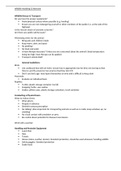Class notes
Wildlife Rescue and Transport
- Institution
- Durham College ( )
Very informative document on how to conduct wildlife rescue and transport in the best manner possible. Covers how to handle and restrain a huge number of animals, as well as equipment needed, zoonotic diseases, and how to avoid injury, amongst other information.
[Show more]



